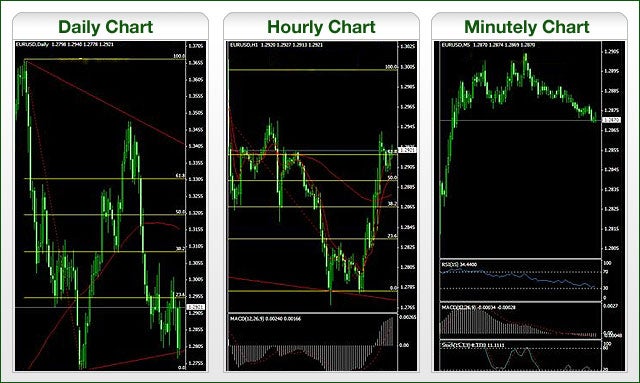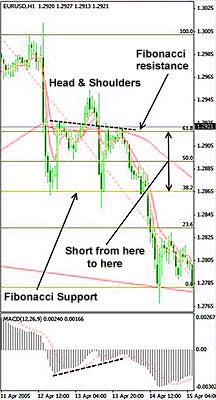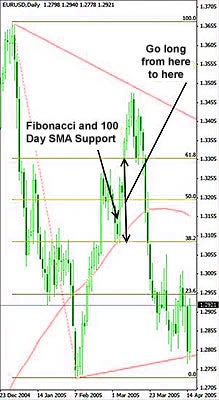Tutorial: Introduction To The Forex Market
Why Medium Term?
So, why are we focusing on medium-term forex trading? Why not long-term or short-term strategies? To answer that question, let's take a look at the following comparison table:
| Type of Trader | Definition | Good Points | Bad Points |
| Short-Term (Scalper) | A trader who looks to open and close a trade within minutes, often taking advantage of small price movements with a large amount of leverage. | Quick realization of profits or losses due to the rapid-fire nature of this type of trading. | Large capital and/or risk requirements due to the large amount of leverage needed to profit from such small movements. |
| Medium-Term | A trader typically looking to hold positions for one or more days, often taking advantage of opportunistic technical situations. | Lowest capital requirements of the three because leverage is necessary only to boost profits. | Fewer opportunities because these types of trades are more difficult to find and execute. |
| Long-Term | A trader looking to hold positions for months or years, often basing decisions on long-term fundamental factors. | More reliable long-run profits because this depends on reliable fundamental factors. | Large capital requirements to cover volatile movements against any open position. |
Now, you will notice that both short-term and long-term traders require a large amount of capital - the first type needs it to generate enough leverage, and the other to cover volatility. Although these two types of traders exist in the marketplace, they are often positions held by high-net-worth individuals or larger funds. For these reasons, retail traders are most likely to succeed using a medium-term strategy.
The Basic Framework
The framework of the strategy covered in this article will focus on one central concept: trading with the odds. To do this, we will look at a variety of techniques in multiple time frames to determine whether a given trade is worth taking. Keep in mind, however, that this is not amechanical/automatic trading system; rather, it is a system by which you will receive technical input and make a decision based upon it. The key is finding situations where all (or most) of the technical signals point in the same direction. These high-probability trading situations will, in turn, generally be profitable.
Chart Creation and Markup
Selecting a Trading Program
We will be using a free program called MetaTrader to illustrate this trading strategy; however, many other similar programs can also be used that will yield the same results. (For more tips on how to find one, see Forex Automation Software For Hands-Free Trading.) There are two basic things the trading program must have:
- the ability to display three different time frames simultaneously
- the ability to plot technical indicators, such as moving averages (EMA and SMA), relative strength index (RSI), stochastics and moving average convergence divergence (MACD)
Now we will look at how to set up this strategy in your chosen trading program. We will also define a collection of technical indicators with rules associated with them. These technical indicators are used as a filter for your trades.
If you choose to use more indicators than shown here, you will create a more reliable system that will generate fewer trading opportunities. Conversely, if you choose to use fewer indicators than shown here, you will create a less-reliable system that will generate more trading opportunities. Here are the settings that we will use for this article:
- Minute-by-minute candlestick chart
- RSI (15)
- stochastics (15,3,3)
- MACD (Default)
- Hourly candlestick chart
- EMA (100)
- EMA (10)
- EMA (5)
- MACD (Default)
- Daily candlestick chart
- SMA (100)
Now you will want to incorporate the use of some of the more subjective studies, such as the following:
- Significant trendlines that you see in any of the time frames
- Fibonacci retracements, arcs or fans that you see in the hourly or daily charts
- Support or resistance that you see in any of the time frames
- Pivot points calculated from the previous day to the hourly and minutely charts
- chart patterns that you see in any of the time frames
 |
| Figure 1: A forex trading program screen |
| Source: MetaTrader |
Finding Entry and Exit Points
The key to finding entry points is to look for times in which all of the indicators point in the same direction. Moreover, the signals of each time frame should support the timing and direction of the trade. There are a few particular instances that you should look for:
Bullish
- Bullish candlestick engulfings or other formations
- Trendline/channel breakouts upwards
- Positive divergences in RSI, stochastics and MACD
- Moving average crossovers (shorter crossing over longer)
- Strong, close support and weak, distant resistance
- Bearish candlestick engulfings or other formations
- Trendline/channel breakouts downwards
- Negative divergences in RSI, stochastics and MACD
- Moving average crossovers (shorter crossing under longer)
- Strong, close resistance and weak, distant support
- Just before areas of strong support or resistance
- At key Fibonacci levels (retracements, fans or arcs)
- Just inside of key trendlines or channels
 |
| Figure 2: A screen showing several indicators that point in the same direction |
| Source: MetaTrader |
In Figure 2, above, we can see that a multitude of indicators are pointing in the same direction. There is a bearish head-and-shoulders pattern, an MACD, Fibonacci resistance and bearish EMA crossover (five- and 10-day). We also see that a Fibonacci support provides a nice exit point. This trade is good for 50 pips, and takes place over less than two days.
 |
| Figure 3: A screen showing indicators pointing in a long direction |
| Source: MetaTrader |
In Figure 3, above, Here we can see many indicators that point to a long position. We have a bullish engulfing, a Fibonacci support and a 100-day SMA support. Again, we see a Fibonacci resistance level that provides an excellent exit point. This trade is good for almost 200 pips in only a few weeks. Note that we could break this trade into smaller trades on the hourly chart.
Money Management and Risk
Money management is key to success in any marketplace but particularly for the forex market, which is one of the most volatile markets to trade. Many times fundamental factors can send currency rates swinging in one direction only to whipsaw into another in mere minutes. So, it is important to limit your downside by always utilizing stop-loss points and trading only when good opportunities arise. (To learn mroe, read Forex: Money Management Matters.)
Here are a few specific ways in which you can limit risk:
- Increase the number of indicators that you are using. This will result in a harsher filter through which your trades are screened. Note that this will result in fewer opportunities.
- Place stop-loss points at the closest resistance levels. Note that this may result in forfeited gains.
- Use trailing stop losses to lock in profits and limit losses when your trade turns favorable. Note, however, that this may also result in forfeited gains.
Anyone can make money in the forex market, but this requires patience and following awell-defined strategy. However, if you approach forex trading via a careful, medium-term strategy, you can avoid becoming a casualty of this market.